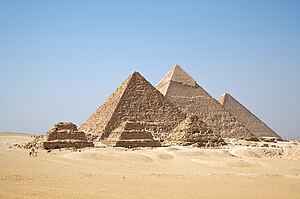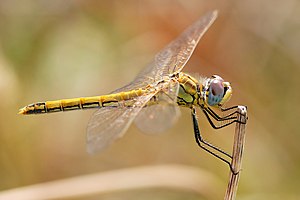Wikipedia:Picture of the day/December 2007
December 1
[àtúnṣe àmìọ̀rọ̀]| Àwòrán Ọjọ́ Òní | |

|
A portrait of Confederate Army General Robert E. Lee in February 1865, two months before his surrender to Ulysses S. Grant at the Appomattox Courthouse. The most celebrated general of the Confederate forces, Lee initially denounced secession as "revolution" and a betrayal of the efforts of the Founders. However, Lee's loyalty was to his home state of Virginia and when it became clear that Virginia would secede, Lee became commander of the Virginia state forces. His victories against superior Union forces won him fame as a crafty and daring battlefield tactician. After the war, Lee discouraged a guerrilla campaign to continue the war, and encouraged reconciliation between the North and South. Photo credit: Mathew Brady |
December 2
[àtúnṣe àmìọ̀rọ̀]| Àwòrán Ọjọ́ Òní | |

|
The skyline of Seattle, Washington at dusk, viewed from the south. The Columbia Center (middle) is the second tallest building on the West Coast of the United States, and the twelfth tallest in the United States. Smith Tower (left), completed 1914, was at one time the fourth tallest building in the world. The highway in the foreground is Interstate 5. Photo credit: Cacophony |
December 3
[àtúnṣe àmìọ̀rọ̀]| Àwòrán Ọjọ́ Òní | |

|
This twelve-year old ARVN Airborne trooper with M79 grenade launcher accompanied the Airborne Task Force Unit on a sweep through the devastated area surrounding the French National Cemetery on Plantation Road after a day-long battle near Tan Son Nhut during the Vietnam War. The young soldier has been "adopted" by the Airborne Division. Photo credit: J.F. Fitzpatrick, Jr., SPC5, U.S. Army Signal Corps |
December 4
[àtúnṣe àmìọ̀rọ̀]December 5
[àtúnṣe àmìọ̀rọ̀]December 6
[àtúnṣe àmìọ̀rọ̀]December 7
[àtúnṣe àmìọ̀rọ̀]| Àwòrán Ọjọ́ Òní | |

|
A winch and associated parts sitting on the deck of the SS Thistlegorm, a transport ship that was sunk by a German bomber during World War II, on 5 October 1941 near Ras Muhammad in the Red Sea. The wreck was originally located by Jacques-Yves Cousteau in 1956, yet only in the last two decades has it become a busy recreational dive site. Photo credit: Woodym555 |
December 8
[àtúnṣe àmìọ̀rọ̀]| Àwòrán Ọjọ́ Òní | |

|
Tin soldiers, approx. 65 mm (2.6 in) high, being cast in German moulds from the early 20th century. The two mould halves are clamped together, and the molten metal, an alloy of tin and lead, heated to approx. 300 °C (572 °F) is poured into the mould. When the metal has solidified, the mould is cracked open. Sprues (pouring channels) and extraneous flash (metal that has penetrated cracks and air channels in the mould) are seen in the third image, and have been removed from the castings in the last image. Photo credit: J-E Nyström |
December 9
[àtúnṣe àmìọ̀rọ̀]December 10
[àtúnṣe àmìọ̀rọ̀]December 11
[àtúnṣe àmìọ̀rọ̀]December 12
[àtúnṣe àmìọ̀rọ̀]| Àwòrán Ọjọ́ Òní | |

|
Macro of a naturally mummified seahorse, which is considered a fundamental ingredient in traditional Chinese medicine (TCM). TCM practices include theories, diagnosis and treatments such as herbal medicine, acupuncture and massage. In the West, traditional Chinese medicine is considered alternative medicine, but in mainland China and Taiwan, it is considered an integral part of the health care system. Photo credit: Jon Zander |
December 13
[àtúnṣe àmìọ̀rọ̀]| Àwòrán Ọjọ́ Òní | |

|
The main pyramids of the Giza Necropolis (front to back): Pyramids of the Queens, Pyramid of Menkaure, Pyramid of Khafre, and Pyramid of Khufu. The pyramids are the sole remaining of the Seven Wonders of the World, and, along with the ancient city of Memphis and the pyramids of Dahshur, are listed as UNESCO World Heritage Sites. Photo credit: Ricardo Liberato |
December 14
[àtúnṣe àmìọ̀rọ̀]| Àwòrán Ọjọ́ Òní | |
| Benito Mussolini and Adolf Hitler |
Benito Mussolini of Fascist Italy (left) and Adolf Hitler of Nazi Germany, two of the Axis leaders of World War II, before one of the Honor Temples of Königsplatz, Munich, sending off their armies to North Africa and into Egypt against the British. The United States declared war on both Italy and Germany on December 11, 1941. Photo credit: Istituto Nazionale Luce |
December 15
[àtúnṣe àmìọ̀rọ̀]| Àwòrán Ọjọ́ Òní | |

|
A female red-veined darter (Sympetrum fonscolombei), a dragonfly common to southern Europe and, from the 1990s onwards, has increasingly been found in northwest Europe, including Great Britain and Ireland. Adults are red (males) or yellow (females), showing beautiful saturated colours. Juveniles are greenish with black stripes on the thorax and abdomen. Photo credit: Joaquim Alves Gaspar |
December 16
[àtúnṣe àmìọ̀rọ̀]| Àwòrán Ọjọ́ Òní | |

|
The American aircraft carrier USS Bunker Hill burns after sustaining two successive kamikaze strikes within thirty seconds during the Battle of Okinawa on May 11, 1945. Nearly 350 died, making this the deadliest kamikaze attack on a US ship during World War II. Although badly damaged, the carrier was able to return to Puget Sound Navy Yard under her own steam. Photo credit: United States Navy |
December 17
[àtúnṣe àmìọ̀rọ̀]| Àwòrán Ọjọ́ Òní | |

|
An animated cut-away diagram of a typical fuel injector, which is used to spray controlled amounts of petrol (gasoline) into an internal combustion engine. A solenoid is activated when fuel is intended to be delivered to the engine, causing the plunger to become pulled toward the solenoid by magnetic force. This uncovers the valve opening, allowing fuel to flow into the atomiser and out the spray tip. The route of fuel is shown in orange; grey/blue indicates no fuel present. Image credit: WikipedianProlific |
December 18
[àtúnṣe àmìọ̀rọ̀]| Àwòrán Ọjọ́ Òní | |

|
|
|
A stitched panorama of the skyline of downtown Portland, Oregon on the Willamette River, taken from the east waterfront. Photo credit: Eric Baetscher | |
December 19
[àtúnṣe àmìọ̀rọ̀]| Àwòrán Ọjọ́ Òní | |

|
A photochrom of Mulberry Street in the borough of Manhattan, New York City, from the year 1900. Mulberry Street is the center of New York's Little Italy and continues into Chinatown. The street is often misidentified as the setting of Dr. Seuss' story, And to Think That I Saw It on Mulberry Street, but that distinction belongs to Springfield, Massachusetts. Image credit: Detroit Photographic Co. |
December 20
[àtúnṣe àmìọ̀rọ̀]| Àwòrán Ọjọ́ Òní | |

|
A panned photograph of a motorcyclist on a Honda CB550 wearing a full-face helmet with a visor, although jeans and laced shoes are usually not considered proper motorcycle safety clothing. Photo credit: Eric Baetscher |
December 21
[àtúnṣe àmìọ̀rọ̀]December 22
[àtúnṣe àmìọ̀rọ̀]December 23
[àtúnṣe àmìọ̀rọ̀]December 24
[àtúnṣe àmìọ̀rọ̀]December 25
[àtúnṣe àmìọ̀rọ̀]December 26
[àtúnṣe àmìọ̀rọ̀]December 27
[àtúnṣe àmìọ̀rọ̀]December 28
[àtúnṣe àmìọ̀rọ̀]December 29
[àtúnṣe àmìọ̀rọ̀]December 30
[àtúnṣe àmìọ̀rọ̀]December 31
[àtúnṣe àmìọ̀rọ̀]| Àwòrán Ọjọ́ Òní | |

|
A sequence of images from the 28 August 2007 lunar eclipse from Swifts Creek, Victoria, Australia. Each image was taken at about a three-minute interval except the last image in the sequence which shows what the moon looked like at about the middle of the eclipse. The majority of the Americas observed an abbreviated eclipse, with moonset occurring at some time during the eclipse. Siberia, far eastern Russia, eastern South Asia, China, the rest of eastern and southeastern Asia, New Guinea, and the rest of Australia missed out on the beginning of the eclipse, because the eclipse occurred at or close to moonrise in those regions. The Philippines, particularly Metro Manila, missed the rare eclipse entirely, due to clouds from the rainy season. Photo credit: Fir0002 |
